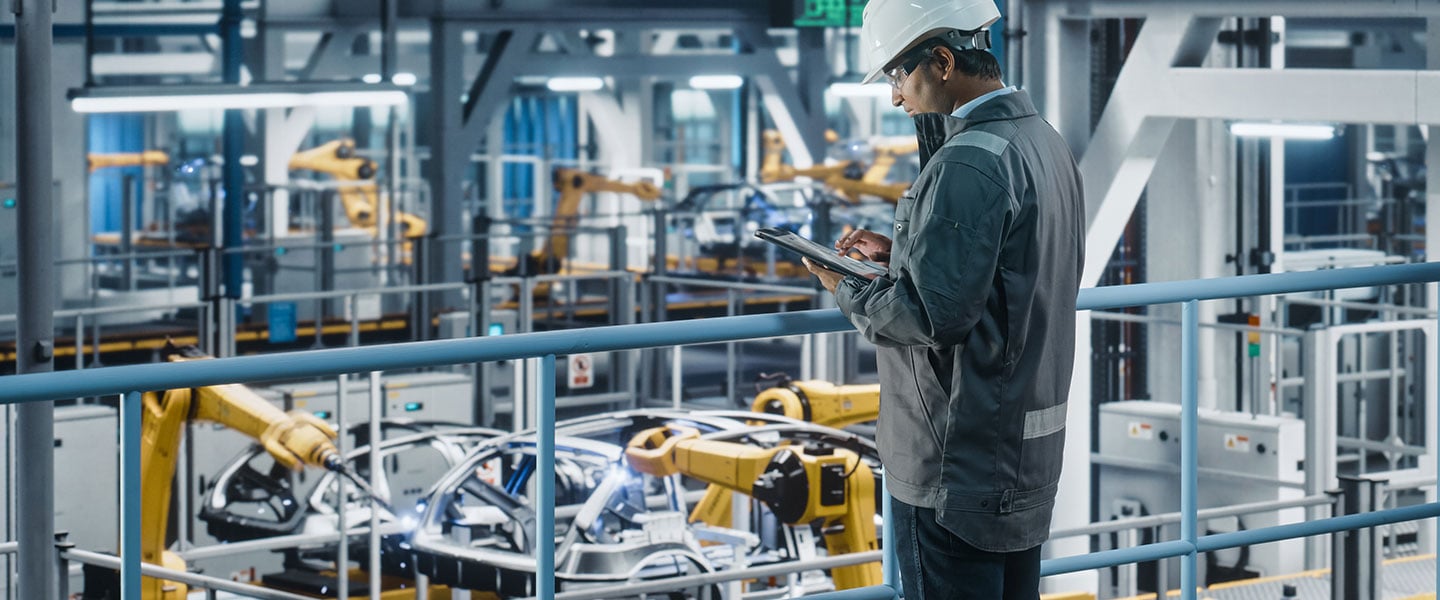-
Business Consulting
Our business consulting specialists offer a comprehensive blend of strategic advisory services. We assess the business, industry, operating model, synergy, skill sets and vision of the organisation and recommend the way forward
-
Digital Natives
Unlock growth with Grant Thornton Bharat's Digital Natives solutions. Customised support for tech-driven companies in healthcare, gaming, and more.
-
Digital Transformation Services
Grant Thornton’s digital transformation services help traditional businesses digitalise their business models with cloud technology, IoT consulting, app development and more DigiTech solutions.
-
Finance Transformation
Using a holistic approach, integrating digitalisation and digital transformation we help clients achieve transparency, control, governance, and faster decision making through real-time data within the business.
-
Human Capital Consulting
Our Human Capital Consulting team harnesses technology and industry expertise to assist in constructing adaptable organisations with transparency, fostering productive and value-driven workforces, and inspiring employees to engage meaningfully in their tasks.
-
Production Linked Incentive Scheme
Production-linked Incentive Scheme by the Indian government is aimed at boosting manufacturing. Grant Thornton Bharat offers varied services across sectors to help businesses avail of this scheme.
-
Public Sector Advisory
Our Public Sector Advisory team has focused streams, aligned with the core priorities of the Government of India. We are responsible for providing innovative and customized technical and managerial solutions.
-
Tech Advisory
We have amalgamated Digital Transformation, IT Advisory & Information Management and Analytics into a new offering, DigiTech.

-
Direct Tax services
Our tax specialists offer a comprehensive blend of tax services, tax litigation, regulatory and compliance services, helping you navigate through complex business matters.
-
Indirect Tax Services
Get tax services by leading tax firm Grant Thornton India. Our indirect tax services include consulting, compliance and litigation services for corporate, international and transaction tax
-
Transfer pricing services
Our transfer pricing services experts provide a range of services from provision of APA services to handling large global assignments including Country by Country reporting.
-
US Tax
At Grant Thornton, we help individuals and dynamic companies deal with US tax laws, which are one of the most complicated tax legislations across the world.
-
Financial Services - Tax
Best financial advisory services, tailored for small and large businesses by the experts having comprehensive knowledge of domestic laws and access to multifaceted tools to provide a valuable results.
-
Financial Reporting consulting services
Our experts have significant hands-on experience in providing IFRS/US GAAP services, end-to-end solutions and support services to fulfil financial reporting requirements.
-
Fund accounting and financial reporting
International operations often lack standardisation and have varied local reporting formats and requirements. Our experts can offer proactive insights, practical guidance, and positive progress and help meet regulatory timeframes.
-
Compliance and Secretarial Services
Our experts can assist in overhauling the entire compliance machinery of the organisation through evaluation of the applicable statutory obligations, monitoring of adequate governance controls, reporting and providing ongoing support.
-
Global People Solutions
As businesses transcend borders, both domestic and global considerations need equal attention. Our interim CFO and financial controller support services help organisations meet the business vision.
-
Finance and accounting outsourcing
Our accounting experts assist organisations in managing their accounting and reporting. Our dedicated Integrated Knowledge and Capability Centre (IKCC), allows us to service both the domestic and global markets efficiently and cost-effectively
-
Compliance Management System
We have automation solutions for you that will allow meeting government requirements and remain diligent, which when failed, can lead to penalties and loss in revenue.
-
Global compliance and reporting solutions
At Grant Thornton Bharat, we meet the challenges of our clients and help them unlock their potential for growth. Our professionals offer solutions tailored to meet our clients’ global accounting and statutory reporting requirements. With first-hand experience of local reporting requirements in more than 145+ locations worldwide, we provide seamless and consistent international service delivery through a single point of contact.
-
Related-party transaction governance
Related-party transactions (RPTs) are common in business structures where organisations engage with their group entities, such as holding companies, subsidiaries, associate concerns, joint ventures, or key management personnel, for various operational or financial purposes.
-
Family Offices & Private Client Services
Grant Thornton Bharat Private Client Services offers tailored advisory for family-owned businesses, focusing on governance, compliance, tax, succession planning, and family office structuring to sustain wealth and preserve legacies across generations.
-
GTMitra: Tax & Regulatory Tool
GTMitra, a specialised tax and regulatory tool by Grant Thornton Bharat, supports multinational businesses in understanding laws and regulations for effective growth strategies.
-
Labour codes
Labour codes solutions help you transition through the new legislation. At Grant Thornton, we help businesses divide their approach to make sure a smooth transition.
-
Alerts
At Grant Thornton India, with the help of our tax alerts, we help to provide updates on how to minimise your tax exposure and risks.
-
Unlocking opportunities: India investment roadmap
The India Investment Roadmap resource is designed to navigate the complexities of Indian tax and regulatory laws, providing seamless guidance and a comprehensive set of solutions to ensure a smooth process for investors aiming to establish or expand their presence in India.
-
CFO Solutions
Our comprehensive suite of solutions for CFOs

-
Cyber
In today’s time, businesses have gone through large transformation initiatives such as adoption of digital technologies, transition to cloud, use of advanced technologies et al.
-
Risk Optimisation
Our Governance, Risk and Operations (GRO) services encompass Internal Audit, Enterprise Risk Management, Internal Financial Controls, IT advisory, Standard Operating Procedures and other services.
-
Risk analytics
Grant Thornton Bharat’s CLEARR Insights is a state-of-the art data analytics platform that will help you in seamless data analysis and efficient decision-making.
-
Forensic & Investigation Services
The team of forensic advisory services experts consists of the best intelligence corporate experts, and fraud risk, computer forensic experts to deliver most effective solutions to dynamic Indian businesses.
-
Digital Forensics and Incident Response (DFIR)
Strengthen cyber resilience with proactive forensic audits
-
ESG consulting
Grant Thornton Bharat offers holistic ESG consulting solutions for sustainable business outcomes. With industry expertise and AI technology, we drive long-term value.

-
Transaction Tax Services
Our transaction tax experts understand your business, anticipate your needs and come up with robust tax solutions that help you achieve business objectives ensuring compliance and efficiency
-
Deal Advisory
Unlike other M&A advisory firm in India, we offer deal advisory services and work exclusively with controlled and well-designed strategies to help businesses grow, expand and create value.
-
Due Diligence
Grant Thornton’s financial due diligence services are aimed at corporate looking for mergers and acquisitions, private equity firms evaluating investments and businesses/promoters considering sale/divestment.
-
Valuations
As one of the leading valuation consultants in India, Grant Thornton specializes in all the aspects of the process like business valuation services, financial reporting, tax issues, etc.
-
Overseas Listing
Overseas listing presents a perfect platform for mid-sized Indian companies with global ambitions. Grant Thornton’s team of experts in listings, work closely with clients during all stages.
-
Debt & Special Situations Solutions
Grant Thornton Bharat offers specialist debt and special situations consulting services, including restructuring, insolvency, and asset tracing solutions.
-
Financial Reporting Advisory Services
Grant Thornton Bharat Financial Reporting Advisory Services offer end-to-end solutions for complex financial requirements, including GAAP conversions, IPO support, and hedge accounting advisory, ensuring accurate financial reporting and compliance.
-
Financial Statement Audit and Attestation Services
Grant Thornton Bharat offers customised financial statement audit and attestation services, ensuring impeccable quality and compliance with global standards. Our partner-led approach, technical expertise, and market credibility ensure effective solutions for your business needs.

- Agriculture
- Asset management
- Automotive and EV
- Banking
- Education and ed-tech
- Energy & Renewables
- Engineering & industrial products
- Fintech
- FMCG & consumer goods
- Food processing
- Gaming
- Healthcare
- Urban infrastructure
- Insurance
- Media
- Medical devices
- Metals & Mining
- NBFC
- Pharma, bio tech & life sciences
- Real estate and REITs
- Retail & E-commerce
- Specialty chemicals
- Sports
- Technology
- Telecom
- Tourism & hospitality
-
 Thought leadership Co-lending in India: Expanding credit access for MSMEsIn today’s rapidly evolving financial landscape, co-lending has emerged as a key enabler of credit expansion in India, facilitating partnerships between banks and non-banking financial companies (NBFCs) to extend credit more efficiently to underserved segments.
Thought leadership Co-lending in India: Expanding credit access for MSMEsIn today’s rapidly evolving financial landscape, co-lending has emerged as a key enabler of credit expansion in India, facilitating partnerships between banks and non-banking financial companies (NBFCs) to extend credit more efficiently to underserved segments. -
 Article Why India’s financial inclusion journey needs to focus on equity and access to creditFinancial services have expanded over a decade, giving millions access to bank accounts and digital payments. But true empowerment needs to reach every corner of the country if growth is to be long-term and sustained
Article Why India’s financial inclusion journey needs to focus on equity and access to creditFinancial services have expanded over a decade, giving millions access to bank accounts and digital payments. But true empowerment needs to reach every corner of the country if growth is to be long-term and sustained -
 Thought Leadership Competitive and sustainable agriculture & food processing in KeralaThe economy of Kerala is primarily driven by the services sector, which contributes 66% to the Gross State Domestic Product (GSDP).
Thought Leadership Competitive and sustainable agriculture & food processing in KeralaThe economy of Kerala is primarily driven by the services sector, which contributes 66% to the Gross State Domestic Product (GSDP). -
 Article Economic Survey 2024-25: Deregulation, investment and innovation for a Viksit BharatIndia's economic growth remains for a steady trajectory with real GDP expected to grow at 6.4% in FY25 and in the range of 6.3%-6.8% in FY26, reflecting resilience despite global uncertainties.
Article Economic Survey 2024-25: Deregulation, investment and innovation for a Viksit BharatIndia's economic growth remains for a steady trajectory with real GDP expected to grow at 6.4% in FY25 and in the range of 6.3%-6.8% in FY26, reflecting resilience despite global uncertainties.
-
Quarterly Aviation Insights
Explore the latest trends in aviation industry with Grant Thornton Bharat’s Quarterly Aviation Insights. Stay updated on industry growth, market shifts & key developments.

-
Freight Forward: Quarterly insights
Logistics sector in India is adapting to rising costs, global disruptions, and the growing urgency of sustainability.
-
India-UK
India-UK

Union Budget 2022 is crucial for upliftment of the beleaguered Indian automotive industry. The double whammy of the global semiconductor shortage and subsequent COVID-19 waves coupled with price hikes for fuel and commodity prices have led to higher input costs for automobiles as well as increase in logistics and shipping costs.
The effect has been seen across all segments and more particularly in the commercial vehicle segment due to lower demand for public transportation. Some immediate measures and a long-term strategy outline from the government in the upcoming budget are requisite for a sector which contributes almost half of the industrial GDP and is experiencing disruptions due to the pandemic as well as advent of new technologies around electric mobility and regulatory changes.
Industry expects the Union Budget to recommend certain provisions to ease the cost of doing business in India as well as incentivise manufacturers to invest in new age technologies and make India a preferred sourcing option in the global supply chain.
Automotive and mobility sector is expected to contribute very significantly for India to achieve its net zero emission status by 2070 through reducing emissions intensity by use of battery operated EV’s which have been identified as a viable option for ICE based vehicles.
The industry, which is now technically dependent on new age technology in electric mobility and peripheral infrastructure, welcomes any foreign or domestic investment across the segments as long as it promotes good value addition and localisation.
However, the current tax structures and pricing of inter-company transactions do impact the earnings and the Union Budget provisions should consider slew of incentives to foreign manufacturers such as concessional financing options, fixed interest subvention on loans availed in Indian Rupees, or a reduction in Minimum Alternative Tax (MAT) and should also consider simplifying the provisions around cross border transactions including transfer pricing procedures.
Further with the advent of mobility as a service (MaaS), clear interpretation regarding Equalisation levy will benefit the non-residents doing business in India. Additionally, bringing in certain relaxations in other regulatory areas such as transfer pricing margins, using specific period data for comparable, use of similar approach and methodology in transfer pricing as for Customs/SVB would surely help provide some needed relief to the sector.
In context to electric vehicles (EVs), states have come out with their own incentives’ schemes for EVs but the segment is yet to see a thrust from the central government dedicated to the establishment of EV infrastructure within the country. While an EV attracts a GST of 12%, lithium-ion batteries, when sold separately, attract a GST of 18%. The GST rates need to be standardised for better promotion of EVs and demand creation.
Also, with over 250 start-ups working on EVs, there is a need to provide necessary fiscal support to start-up enterprises which would further help in reducing the cost of e-mobility; pushing industry’s futuristic goal of net-zero carbon emissions in vehicles. Majorly, some new policy initiatives for EVs and inverted duty structure for components which were missed in the earlier budget announcement need to be emphasised on.
One of the key challenges the auto component industry faces is the widespread counterfeiting of auto parts causing losses to component players to the tune of over $15 billion. One of the reasons for growing grey is the high GST rate on auto components. A much more stable GST rate for auto components will play a crucial role in not only moderating the cost of vehicles but also in reducing the grey market operations.
There is a need to make the vehicles affordable (particularly the electric vehicles) for the end consumer as with the new stage of Corporate Average Fuel Economy (CAFE) norms, from next fiscal, further hike in prices is likely to happen. Apart from this, some cost percentage is being passed down to consumers, as industry witnesses stressed financials on the back of increased commodity prices.
If the government’s course of action is aligned with stabilising commodity prices, it will definitely help bolster consumer demand. Considering, amid the economic slowdown, the regulators had earlier made indelible efforts and implemented numerous norms to improve the safety aspect of vehicles and reduce harmful carbon emissions which have augured well for consumers and for the overall nation.
Altogether, the industry entails advanced automotive technologies in the global supply chain and reduced prices of new vehicles. Introduction of benefit in form of the much awaited RoDTEP scheme, with benefit varying between 0.5-1.5%, even though not comparable to erstwhile MEIS scheme (both having different objectives), was taken as a fair move by the industry especially in the two-wheeler segment and has some positive impact on the overall costs incurred.
There stands some bit of room to revisit this benefit especially for other segments apart from two-wheelers. In addition, the recently introduced Production-Linked Incentive (PLI) Scheme in the automobile and auto components sectors with specific focus on EV segment, is another significant step which envisions higher demand creation.
While it needs to be seen how the scheme will ultimately perform at an overall level, the industry has welcomed the move and is also awaiting addition of more products as part of the remaining budget outlay that was initially planned for this sector.
For the market suffering the after-effects of COVID-19, rising fuel prices have further been detrimental to consumer demand. With multiple pain-points as discussed above, there is a high expectation from the government in the upcoming budget to take useful steps and make constructive projections for the automobile industry to post growth in the coming financial year.
This article was originally published in The Times of India.

